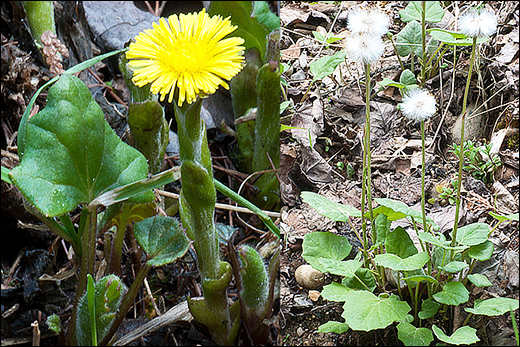Coltsfoot / Tussilago farfara – Classification, Ayurvedic Properties & Dosage
Description
Tussilago farfara is a European herb found in the western Himalayas, northern China, and Persia. It has a long history of use in traditional medicine for treating a variety of respiratory ailments. Herbs are used worldwide to treat conditions and even severe disorders, and numerous research studies have demonstrated their effectiveness. The absence of side effects is the most significant advantage of herbal medications.

Introduction
Tussilago is derived from the Latin words “tussis,” which means cough, and “ago,” which means to act on. Tussilafo farfara, commonly known as coltsfoot. This plant is from the tribe Senecioneae and belongs to the family Asteraceae. This plant is native to Europe and parts of Western and Central Asia. In Europe, the leaves of coltsfoot have been used, whereas in other countries, the whole plant is used. This medicinal herb is traditionally used as an herbal remedy, mainly for the treatment of respiratory tract-related problems due to the presence of several chemical constituents.
Classification of Tussilago farfara
- Kingdom: Plantae
- Division: Magnoliophyta
- Class: Magnoliopside
- Order: Asterales
- Family: Asteraceae
- Genus: Tussilago
- Species: T. farfara
Synonyms Of Tussilago Farfara
- Cineraria farfara
- Farfara radiata
- Tussilago alpestris
- Tussilago umbertina
Habitat
Coltsfoot is quite flexible in terms of soil and moisture. This species can easily occur in a wide variety of soils, including clays, slits, loams, and sandy loams. This can grow in infertile to very fertile soils but can also be grown in dried areas, like in partial shade or full sun. This plant is easily seen in disturbed open areas, often on roadsides. This is the first flower to be found in the spring.
Morphology
Tussilago farfara belongs to the family Asteraceae and is a perennial herbaceous plant. Stems are erect, and unbranched and arise from the ground in small clusters before the basal leaves. They have a height of around 10 to 50 cm. European coltsfoot has two types of leaves: flowering stem leaves and basal leaves. The leaves of flowering stems are linear and small, ranging in size from 1 inch, arranged in intervals. The flowering stems have sparse, long hairs and purple-tipped glands. The basal leaves, developed after the flowering stems, are heart-shaped and have a height of around 13.8 inches. They are irregularly arranged and have slightly toothed margins. The coltsfoot flowers bear a yellow color, similar to the dandelions, but these have disc florets and numerous ray florets that are borne on the scaly stems.
Parts Used
Leaves, Flower bud
Phytochemical Constituents Of Tussilago Farfara
- Alkaloids – The pyrrolizidine alkaloids found in Tussilago farfara are senkirkine and senecionine. These alkaloids are quickly eliminated from the body through urine. Senecionine can treat diabetes, and hemorrhage and is a uterine stimulant.
- Flavonoids – The flavonoids apigenin and luteolin have been isolated and found in the coltsfoot flower and stem extract. Apigenin and luteolin have anti-cancer properties because they can prevent the growth of various cancer cells. The flower buds of coltsfoot contain kaempferol 3-0-rutinoside and hyperoside (flavonol glycoside). They have anti-inflammatory properties and a variety of potent pharmacological activities.
- Phenolic Compounds – The phenolic compounds present include phenylmethane, phenylpropane, and some phenylpropanoic acid esters. The aerial parts of Coltsfoot contain syringic and gallic acid. Additionally, chlorogenic and rosamarinic acids are the most abundant.
- Sesquiterpenes – The T. farfara plant contains a variety of compounds, including sesquiterpenes, which are the primary active principles in coltsfoot flower buds. Oplopane, bisabolane, and many other substituents are found in diverse varieties.
- Triterpenoids – The flower buds of coltsfoot contain triterpenoids known as arnidiol and faradiol.
- Organic Acids – Ascorbic acids, malic acids, and citric acid are found in the leaves of coltsfoot through the HPLC technique.
- Amino Acids – Phenylalanine, valine, and other essential amino acids are also present.
Benefits Of Coltsfoot
1. Beneficial Effects Of Coltsfoot On The Tussive (Cough)
The flower buds and leaves of Coltsfoot have been used to treat coughing, shortness of breath, asthma, and other pulmonary problems. In Europe, coltsfoot leaves have traditionally been used to treat bronchial infections and severe respiratory symptoms. In Norway, the dried and sliced leaves of coltsfoot are used as folk medicines and sold in the form of teas that provide help from coughs and chest ailments. So, coltsfoot possesses antitussive effects.
2. Beneficial Effects Of Coltsfoot In Skin Care
Coltsfoot possesses skin rejuvenating properties that make the skin appear younger, and as a result, it is in high demand in the beauty sector. Coltsfoot also contains antioxidants, which benefit the skin. Coltsfoot improves skin conditioning and decreases oxidative stress.
3. Beneficial Effects Of Coltsfoot On Microbial Activity
Coltsfoot investigations revealed the strongest antimicrobial activity, which could be attributed to the synergistic effect. Consuming coltsfoot herb in the form of tea boosts the immune system by improving lymphatic discharge in the body and also helps to heal allergies. It is also used to treat cystitis and other urinary tract infections due to its strong antibacterial characteristics. Coltsfoot showed broad-spectrum action against microorganisms. In vitro studies validated the plant’s use as traditional medicine to treat a variety of diseases, including tuberculosis.
4. Beneficial Effects Of Coltsfoot On Neuro-Protective Activity
The flower bud extracts of coltsfoot showed neuroprotective effects against oxidative stress-induced neuronal cell damage in cortical cells. This plant can improve human memory and help avoid acute and chronic neurodegenerative illnesses including Alzheimer’s disease and strokes.
5. Beneficial Effects Of Coltsfoot On Cancer Activity
Coltsfoot flower buds include several sesquiterpenoids that have been shown to kill cancer cells. In vitro research revealed that a homogeneous polysaccharide promotes apoptosis while inhibiting growth. Furthermore, the investigations found that T. farfara extracts can treat angiogenesis-dependent illnesses. Interestingly and surely, chemotherapy causes damage to both tumor and healthy cells with strong proliferative activity, so coltsfoot polysaccharides aid in the treatment of chemotherapy-induced adverse effects.
6. Beneficial Effects Of Coltsfoot On Diabetes
Coltsfoot contains several bioactive compounds; the rosmarinic and chlorogenic acids have shown anti-diabetic properties. The extracts of coltsfoot show inhibition of alpha-amylase and alpha-glucosidase activity, which can reduce the postprandial increase of blood glucose. Thus, it manages the blood glucose level in type II diabetes.
Substitutive Herbs For Tussilago Farfara (Coltsfoot)
- Taraxacum officinale (Dandelion)
- Bacopa monineri (Brahmi)
- Glycyrrhiza glabra (Licorice)
- Withania somnifera (Ashwagandha)
- Tinospora cordifolia (Giloy)
1. Taraxacum officinale / Dandelion / Dudhali, / Payasvani
Here the name indicates “taraxos,” which means disorder, and “akos,” which means remedy. And “officinale” denotes a plant with medicinal properties. This perennial plant, commonly known as Dandelion, comes from the family Asteraceae. The yellow flowers and jagged leaves distinguish this plant, which stands about 40 cm tall.
Ayurvedic Properties of Taraxacum officinale
- Rasa (taste)- Tikta (bitter) and Katu (pungent).
- Guna (qualities) – Laghu (light for digestion).
- Ruksha (dry), – Veerya (potency), is Ushna (hot).
- Karma (actions) – Kaphapitta shamaka (reduces vitiated kapha and pitta dosha).
Action On Doshas Of Taraxacum officinale
- Vata Balancing (to treat constipation) – The bitter taste helps stimulate digestive juices, and dandelion roots and leaves aid in digestion.
- Pitta Nourishing – Dandelions have detoxifying properties and, if consumed in the form of tea, are great for excessive pitta, which can help to remove excess heat from the liver and blood.
- Kapha Nourishing (boosts immune system) – As dandelion green is a source of vitamins and nutrients, it supports overall health and immunity.
2. Bacopa Monineri / Brahmi
Brahmi is an important medicinal plant and is a small perennial herb that comes from the family Scrophulariaceae. Brahmi is the best nervine tonic, which helps in reducing anxiety, depression, weak nerves, and dizziness.
Ayurvedic Properties Of Bacopa Monineri
- Rasa (Taste) – Tikta (bitter), Kashaya (astringent).
- Guna (qualities) – Laghu (Light to digest)
- Vipaka ( taste after digestion) – Madhura (sweet)
- Veerya (potency) – Sheeta (cold).
- Prabhava – Medhya (improves intelligence).
Action On Doshas Of Bacopa Monineri
Helps in Balancing Tridoshas: particularly managing Vata and Pitta.
- Vata – Brahmi alleviates the symptoms related to the nervous system. This herb is useful to manage the anxiety that occurs due to the vata imbalance.
- Pitta – Due to its cold potency, Brahmi is especially beneficial for pitta disorders. It can support digestive health which may improve symptoms like gas, bloating, and indigestion.
- Kapha – Depression is caused due to an increase in kapha dosha, bhrami exhibits an improvement in a depressed mood, and also reduces anxiety and agitation.
3. Glycyrrhiza Glabra / Licorice / Mulethi / Yashtimadhu
Glycyrrhiza glabra, or licorice, is a member of the Leguminosae family. This Ayurvedic herb, called Ayurveda Yashtimadhu, is widely utilized and regarded as a vital herbal medicine. It is a natural sweetener with antitussive effects that help ease coughs, chest congestion, and sore throats, improve voice, and boost strength and immunity.
Ayurvedic Properties Of Glycyrrhiza Glabra (Licorice)
- Rasa (taste) – Madhura (sweet).
- Guna (qualities) – Guru (heavy), Snigdha (unctuous)
- Veerya (potency)- Sheeta (cold)
Action On Doshas Of Glycyrrhiza Glabra (Licorice)
- Vata – This helps balance the vata by promoting relaxation and supporting digestion.
- Pitta – Mulethi’s sweet taste and cold potency help in pacifying pitta.
- Kapha – Mulethi supports respiratory health, prevents congestion, and also improves mucus flow.
4. Withania Somnifera / Indian Ginseng / Ashwagandha
Ashwa means “horse” and Gandha means “smell” and comes from the family Solanaceae. This herb is very powerful so is called as “king of herbs”.
Ayurvedic Properties Of Withania Somnifera
- Rasa (taste) – Katu (pungent), Tikta (bitter) and Kashaya (astringent)
- Guna (qualities) – snigdha ( oiliness, unctuousness), Laghu (lightness)
- Veerya (potency) – Ushna (hot).
Action On Doshas Of Withania Somnifera
Balances all the tridoshas
- Vata – Ashwagandha has a vata balancing property and gives relief from the symptoms of arthritis-like pain, and swelling in joints.
- Pitta – This herb can sometimes aggravate pitta in excess. But if mixed with other herbs can balance out those heating qualities.
- Kapha – Ashwagandha is very effective in balancing kapha. This can help the body to deal with stress, improving the immune system and regulate cardiac activities.
5. Tinospora Cordifolia / Giloy / Guduchi
Tinospora cordifolia commonly called Guduchi belongs to the family Menispermaceae. This plant is important in traditional Ayurvedic medicines that have been used for ages in the treatment of fever, diarrhea, eye disorders, arthritis, and cancer.
Ayurvedic Properties Of Tinospora Cordifolia
- Rasa (taste) – Tikta (bitter) and Kashaya (astringent)
- Guna (qualities) – snigdha ( oily, unctuous), Laghu (lightness)
- Veerya (potency) – Ushna (hot)
- Vipaka ( taste conversion after digestion) – Madhura (sweet)
Action On Doshas Of Tinospora Cordifolia
- Vata – Guduchi is useful in problems related to vata like arthritis, hypertension, and weakness.
- Pitta – improves the agni (digestive fire). Help in alleviating pitta-related disorders such as skin problems, gastritis, and liver issues.
- Kapha – Guduchi shows excellent results in kapha-related issues in two ways: due to its Ushna virya property and Rasayana property it can boost the immune system and fight against the foreign particles.
Conclusion
This article discussed Tussilago farfara, a European native herb, and other Ayurvedic herbs, both of which have numerous health benefits for humans. Every plant contains phytochemical constituents, as well as other metabolites like organic acids, amino acids, and polysaccharides. These are the fundamental ailments that serve therapeutic purposes. There are numerous plant species found all over the world. However, it is impossible to reap the benefits of every plant. Numerous alternative herbs work in the same way and treat the disorder. In this article, we will conclude the substitute herbs for Tussilago farfara, which is native to Europe. Ayurvedic plants such as Brahmi, Licorice, Ashwagandha, and Giloy fight off many antigens and treat respiratory tract infections, bone problems, anxieties and depression, sleeping disorders, and other nervous system conditions. All of these herbs have great Ayurvedic benefits and have been used since antiquity.



